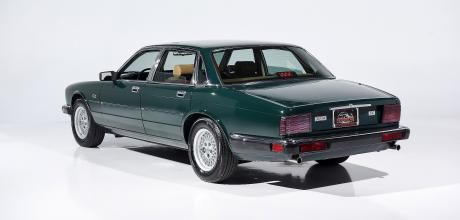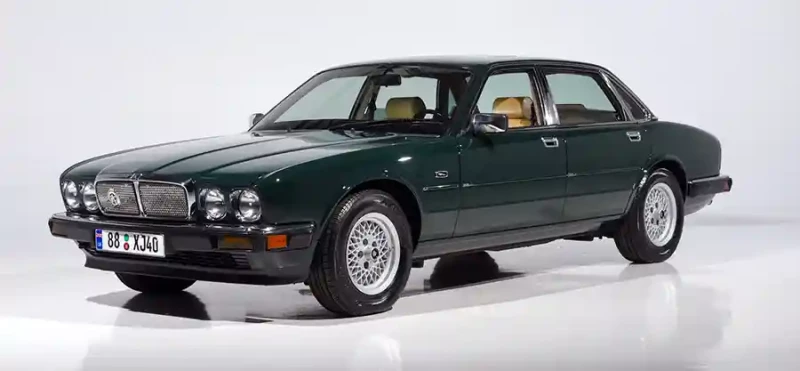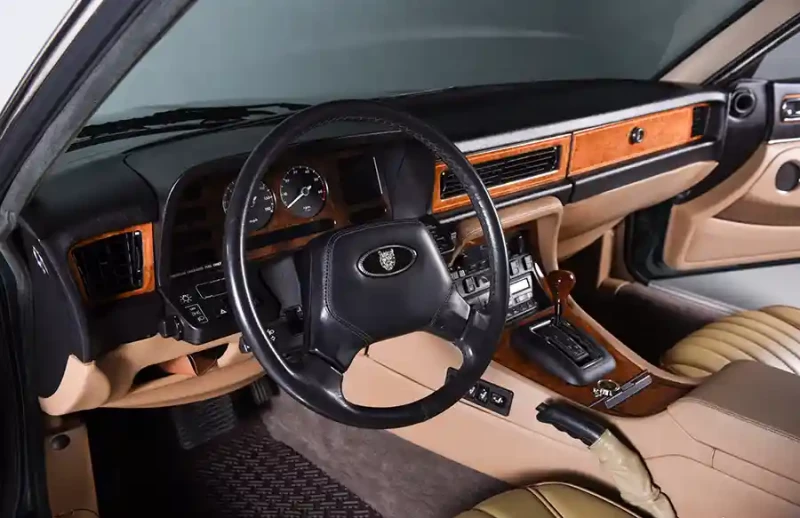Buyers Guide Jaguar XJ40

What you need to know to buy the best of this underrated family.
WORDS: SAM SKELTON
PHOTOGRAPHY: PAUL WALTON
JAGUAR XJ40 BUYING GRAB A MODERN CLASSIC
How to buy the best value classic Jaguar saloon.

Earlier in this issue, Paul Guinness told the story of Jaguar’s short-lived window of privatisation under the Thatcher governments of the 1980s. A story which is best remembered through one model – the XJ40. A car that was initially planned under the auspices of British Leyland, launched by a newly privatised company and which showed the world just how good an investment Jaguar could be – ultimately, encouraging a Ford buyout. And while it was a long time coming, it was an all new model rather than a facelift of what had come before. It had a new body, a new engine family (albeit one previewed in the XJ-S 3.6, and a new interior with a forward thinking LCD display for a dashboard. Launched on 8 October 1986, prices ranged from £16,495 for the XJ6 2.9 through to £28,495 for the Daimler 3.6. Over time the range evolved, with new 3.2 and 4.0 engines and new trim levels expanding the three model range into a whole model family ahead of its 1994 replacement by the X300. Today, it’s the ideal starter classic for those looking for a Jaguar to enjoy regularly.
BODYWORK
Generally, the advice here is that the later the car, the better – though the revised layout introduced in 1992 with the battery relocated to the boot does bring new challenges of its own. Check where the upper wishbones mount to the front subframe, and around the suspension turrets, as these are major rot spots. The front bulkhead can also be concerning, particularly on the later battery in boot cars and we would recommend removing the trim under the windscreen wiper to inspect this thoroughly if possible. Inner and outer sills can rust through too, and like its successor the X300 we’d advise getting your hands in behind the front wheels to check the state of the inner wings where they meet the sill panels. Cosmetically they can bubble on the doors, arches and front wings, but this shouldn’t affect them structurally. Check the radiators support panel as these rot, but as they’re bolt on they aren’t a big deal to replace. Also check the screen frames, as rust here can let in water. An unusual point to check is the bolts for the bumpers – bumpers were easily stolen in the 1990s and desirable, and many owners took to defacing the bolts to prevent removal. This might have been clever then but may affect repair work as these cars age, so intact bolts are a better bet. Bumpers themselves may have distorted over the years or attracted parking scrapes – there’s little that can be done about these but if they’re not too unsightly they shouldn’t adversely affect the value of the car. Not strictly bodywork, but we should point out that until 1990 XJ40s were fitted with metric wheel designs – 390mm. Tyres can be tricky to source new and we wouldn’t recommend the use of old stock tyres. For cars fitted with alloys, a similar style was used in 15” format after 1990 and it will be hard to see the difference, though sadly for cars on steel wheels the original trims won’t fit 15” wheels properly. In either case, we would advise that safety is paramount and wouldn’t consider an older car devalued by imperial wheels.
“Until 1990 XJ40s were fitted with metric wheel designs – 390mm. Tyres can be tricky to source new.”
ENGINE AND TRANSMISSION
With adequate maintenance the AJ6 is about as close as it gets to a truly bulletproof engine. A growl or moo from the front is likely to be the timing chain tensioner, but these can be refurbished or replaced and in many cases present enough warning to avoid a failure. Head gaskets can fail – it’s rare but eminently possible, so check for sludge in the oil cap. The 3.6 can weep oil from the front corner of the head – it’s not necessarily an issue, just keep an eye on the levels. Most come with the four speed ZF automatic transmission, fitted with a Sport mode in the case of the 4.0s. Check the state of the fluid – you want cherry red, brown is in need of a change and black is serious bad news. If you can’t get it out of P, it’s an issue with the safety interlock or the brake light switch at the pedal.
Check it engages D and R smoothly, any loud clonking is likely to be the differential. Diffs can get noisy as they pass 100,000 miles, but as long as there is no clonking they’re typically quite reliable and a little noise shouldn’t worry you. The output oil seal at the prop can leak, and this should be checked. Finally – as it’s under the bonnet – be wary of any car that “just needs an aircon regas”. If it’s leaking, it’ll present again as a fault and if it isn’t, why has the seller not spent the £60 or so to have it gassed before sale? It’s worth noting that earlier cars use R12 gas and will need conversion to run with R134a. Drop in gases exist for R12 systems but can be expensive.
SUSPENSION, STEERING AND BRAKES
The self levelling suspension system optional on early cars is prone to failure and can be expensive to sort out – many owners have done as Jaguar itself suggested in period and “de-specced” it to use conventional springs and dampers. It’s crucial to so the springs as well as the dampers as the self levelling springs are shorter, so if this has been done ask to see the invoices. XJ40s are also hard on bushes, front wishbone and rear A frame in particular can leave a car feeling a bit loose and can induce the odd clonk. Some bushes are easier than others to replace at home, but a good specialist such as David Marks Garages will make light work of a full refresh. Discs and pads wear fairly quickly on XJ40s given that these are large cars and engaging enough to drive hard – you can replaced discs and pads at either end for less than £100 if you shop around. It’s also a DIY prospect given that Jaguar abandoned the inboard rear discs for this model.
Pre 1990 XJ40s use a pressure accumulator in the manner of an old Citro.n instead of a conventional servo to provide power assistance to the braking system. If the ABS or brake warning lights stay on for longer than they should, the odds are that this is faulty or leaking. Many owners have converted their cars to run conventional vacuum servos – a kit is available from Jaguar Specialties in America to do this, which has been described as “fit and forget” by those who have used it but which will count as a modification for insurance purposes. Expect to pay something in the region of £750 plus fitting, when the shipping and customs fees have been factored in. The later Teves braking system from 1990 onwards is a more reliable system, and should pose no issues. There is little to go wrong with the steering system – it’s a relatively basic hydraulic PAS system. Nonetheless, it’s worth checking the PAS fluid level and quality, and making sure that there are no leaks. XJ40 steering is fairly light so if it’s heavy, assume problems.
INTERIOR AND TRIM
The Ford influence on quality means that the later cars are by far the better bets, though the earlier ones have their fans owing to their tech-led design. The LCD dashboard fitted pre 1990 was seen as overly complex in its day, but many of the troublesome ones have now been scrapped and realistically few will be problematic now if they’ve lasted almost 40 years. One electronic tip we’ve heard is that the bulb failure modules can pose error messages, typically on pre 1990s cars. These cars used metal modules, while 1990-1992 cars typically used a plastic module. They are more reliable and directly compatible. The same trick applies to climate control panels – they can often act up on early cars, but parts from the 1991 model year are a straight swap and offer improved reliability. Exterior door handles can break on pre 1990 cars, but again it’s a case of finding a later component to swap in. In terms of interior trim, it all lasts fairly well – leather can split and crack with age but any competent trimmer can put this right, while general wear can be revived with a leather recolouring kit. Headlinings can sag, but these can be retrimmed – we would advise reusing the existing board rather than sourcing a replacement, and we have achieved more long term success using 3M Display Mount glue rather than anything explicitly sold for interior trim. Later cars could be had with custom paint and trim finishes from the Insignia range – these will be harder to match and it’s worth checking that these are in good condition if you’re looking to buy one of these special models. Leather-trimmed dashboards will be especially hard to replace.

VERDICT
The XJ40 has long been maligned as the BL Jag, the square one, even Inspector Morse once went on record as suggesting it had no class at all. But that was then, and this is now – and the square jawed 1980s aesthetic of these cars has never been more in favour. Prices are really starting to solidify now, and while the XJ40 had a reputation for troublesome electrics early in its life the majority of the problem cars no longer exist – making an XJ40 every bit as safe a bet for preservation as anything that came before.
It's better value than a Mercedes-Benz S-class of the same age, and offers more style and soul than contemporary Audis and BMWs. And best of all, the XJ40 enjoys an almost enviable position in terms of specialists, with few large 1980s saloons having anything like the same level of support in the UK. The only choice we really think you should have to make is what model to buy. Do you want the rarity of the 2.9 manual or the luxury of a Daimler 4.0? Regardless of your tastes, an XJ40 could well be the ideal starter classic.
VALUES
XJ40s have spent a long time in the doldrums as far as values are concerned – we know of several people who’ve spent less than £500 on buying an MoTed example in the last decade. But the market is changing and an increased awareness of 1980s cars means that good examples are now fetching money that hasn’t been possible since the mid 1990s. For the very best Daimlers and Sovereigns you can spend up to £10,000 today – likewise the limited run TWR XJR models. However, most aren’t quite of the standard necessary to achieve that sort of figure quite yet. At £5000 you should have plenty of choice of nicer cars of all specifications, and this is what we’d advise you spend unless you want a show car. £2500- 3000 will buy you a usable car but one that will have a number of jobs necessary to make it nice. In terms of spec, the 2.9s are worth about 20% less than the 3.6 and 4.0 models. 3.2s are more valuable but still worth about 10% less like for like. A Daimler can command a 15-20% price premium on average – some sellers try for more but realistically it’s not worth the extra for the crinkle cut grille and picnic tables unless you really want a Daimler badge. And as with any old car, we’d rather buy on condition. An automatic gearbox used to be crucial, but there is a limited market for manual examples. Air con Is always desirable, as are alloy wheels, and you’ll find it difficult to sell any XJ without leather trim unless you find one of the few enthusiasts who want something different.
WITH THANKS TO: Alex Sebbinger-Sparks, who runs the Modern Classic Jaguars page on Facebook.
“For the very best Daimlers and Sovereigns you can spend up to £10,000 today – likewise the limited run TWR XJR models.”
TECHNICAL DATA 1986 JAGUAR XJ6 2.9
- ENGINE: 2919cc I6
- MAX POWER: 165bhp
- MAX TORQUE: 176lb ft
- ACCELERATION 0-60MPH: 9.5secs
- TOP SPEED: 123mph
- ECONOMY: 20mpg
- TRANSMISSION: 5-spd man/4-spd auto
- PRICE NEW: £16,495
- VALUE NOW: £2000-£8000
TECHNICAL DATA 1993 DAIMLER 4.0
- ENGINE: 3980cc I6
- MAX POWER: 235bhp
- MAX TORQUE: 285lb ft
- ACCELERATION 0-60MPH: 7.1secs
- TOP SPEED: 138mph
- ECONOMY: 23mpg
- TRANSMISSION: 4-spd auto
- PRICE NEW: £46,700
- VALUE NOW: £2500-£10,000
“While it was a long time coming, it was an all new model rather than a facelift of what had come before.”
JAGUAR XJ40 TIMELINE
- 1986 Jaguar XJ40 series launched, three model range comprising XJ6, Sovereign and Daimler with 2 engine options available (2.9 and 3.6).
- 1988 TWR XJR 3.6 model introduced.
- 1989 3.6 litre engine replaced by 4.0 litre unit. LCD display dashboard replaced by analogue unit.
- 1990 2.9 litre engine replaced by 3.2 litre unit.
- 1993 New 3.2S and 4.0S models introduced, targeting younger buyers with sporting spec. New 3.2 and 4.0 Gold models introduced as run-out specials with a number of options fitted as standard. XJ12 and Daimler Double Six introduced, though outside the scope of this guide.
- 1994 All models replaced by X300 family.

